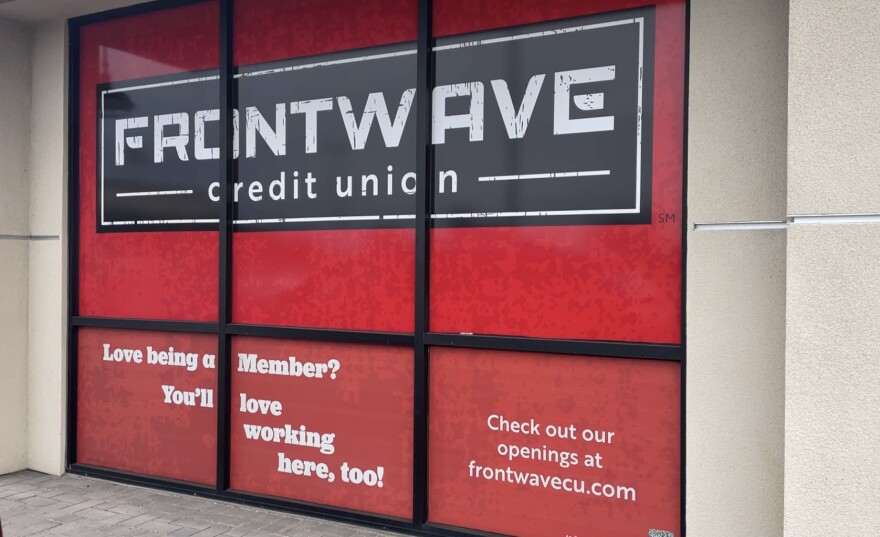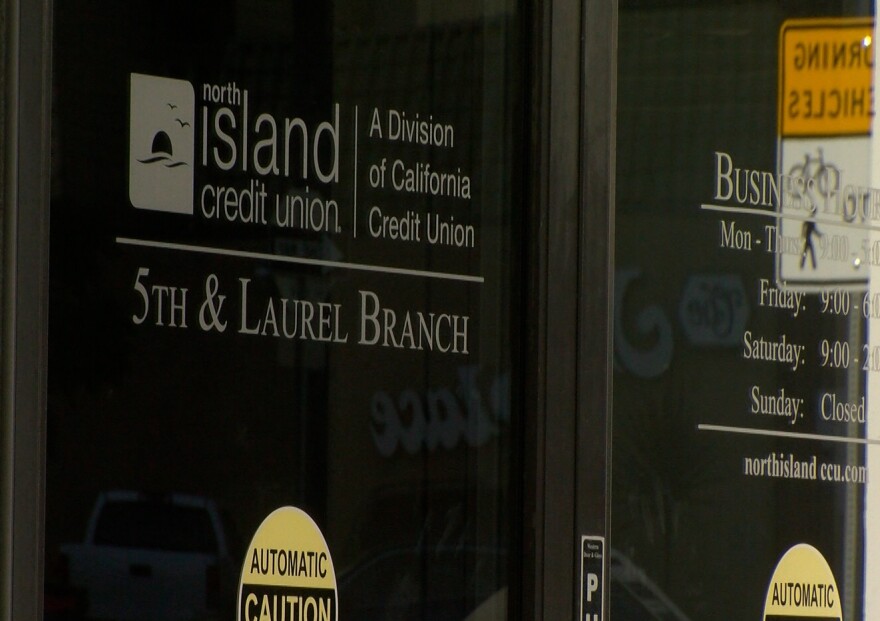This is part one of a two-part series. Read part two here.
Ernie left the San Diego County Credit Union on El Cajon Blvd in a huff on a recent Thursday afternoon.
Wearing dark sunglasses and a beanie, he declined to give his last name and wasn’t feeling very talkative. Hard to blame him — earlier that day, the credit union hit him with an overdraft fee.
“I think it’s sh—y because they take fees every month,” he said.
Ernie is certainly not the only San Diego County Credit Union (SDCCU) member feeling crappy about overdraft penalties. The credit union charges $32 per overdraft and last year generated $18 million in revenue from the fees.
SDCCU declined an interview request and did not respond to multiple follow-up inquiries.
All told, credit unions chartered in California collected more than a quarter billion dollars in overdraft fees in 2022, according to data collected by the state. A KPBS analysis found state-chartered credit unions based in the San Diego area collected more than $36 million.
Revelations in recent years of onerous fees charged by mammoth banks like Wells Fargo and Bank of America have led to lawsuits and government crackdowns. But unlike commercial banks, not-for-profit credit unions haven’t had to disclose revenue generated from overdraft penalties.
That changed in California this year, following the passage of a first-of-its-kind law requiring the collection of this information. A report released by the state Department of Financial Protection and Innovation (DFPI) provides a revealing snapshot of how certain institutions depend on the fees. The KPBS analysis found overdraft fees at several San Diego area credit unions amounted to at least half of their net income. In one case, an area credit union’s financial records indicate it could have lost money last year without revenue from overdraft penalties.
Overdraft fees disproportionately impact customers living paycheck to paycheck, since they’re more likely to have low checking account balances. Banking watchdogs said excessive overdraft penalties effectively punish people for being poor.
“Regulators should treat overdraft (fees) as a five alarm fire that is burning through low-income communities,” said Aaron Klein, senior fellow in economic studies at the Brookings Institution. “It's so expensive to be poor in America. Credit unions ought to be solving that problem, not exacerbating it.”
Many credit unions boast about their commitment to community investment. Some even have designations from the federal government for serving low-income populations. But the revenue credit unions generate from overdraft penalties can dwarf the amount of money they invest back into the community.
The California and Nevada Credit Union Leagues, a trade association, did not respond to multiple interview requests.
_
New law forces disclosures
For everyday people, credit unions and banks serve similar functions. They offer checking and savings accounts, credit cards and loans. But they operate under different sets of rules.
Credit unions don’t have customers, they have members — and those members technically own the credit union. Membership eligibility can be based on a variety of factors, such as a person’s geographic location or employer.
Banks are for-profit businesses; credit unions are not-for-profit. That means any profits a credit union makes are supposed to benefit its members in the form of things like reduced fees, higher savings interest rates and better loan options. The not-for-profit status also means credit unions enjoy certain tax and regulatory advantages, as well as the PR sheen that comes with the label.
“Credit Unions have largely escaped scrutiny by a combination of wrapping themselves in the ‘good guy’ flag as a nonprofit, mission-oriented entity and by not releasing data to the public,” Klein said.
Avoiding disclosure of overdraft fees, Klein said, is a prime example.

For years, the federal government has required large federally-chartered commercial banks to disclose their income from overdraft fees. The numbers weren’t pretty. Big banks — like JP Morgan Chase, Bank of America and Wells Fargo — collectively brought in between $11 billion and $12 billion annually from overdraft penalties before the pandemic. Small banks also relied on the practice.
With new sunshine on a dark corner of their financial books, and with swelling frustration from the public and politicians, many banks started reforming their overdraft practices. Some softened their penalties by reducing fees or offering grace periods. Capital One, which used to charge up to $35 per overdraft, eliminated the fees altogether. As a result, overdraft revenue at bigger banks dropped nearly 50% last year, according to the Consumer Financial Protection Bureau.
Credit unions, on the other hand, have largely avoided scrutiny.
David Silberman, lecturer at Harvard Law School and senior fellow at the Center for Responsible Lending, said that’s created a “blind spot” for assessing how much money Americans are forking over every year in overdraft fees.
But the new reporting requirements in California, he noted, “helps to fill in that gap.”
In March, DFPI released its first annual report on overdraft revenue at state-chartered credit unions and banks, as required under last year's SB 1415. (The report details revenue from “overdraft fees” and “nonsufficient fund fees.” The former is when a customer overdraws an account and the transaction goes through; the latter is when the transaction is declined. This story refers to the penalties collectively as overdraft fees.)
The DFPI report shows the prevalence of these fees in the industry.
“Some credit unions have become addicted to overdraft,” Klein said, explaining that the fees are a key revenue source.
California’s 114 chartered credit unions collected more than $250 million in overdraft revenue last year, KPBS' analysis shows. By comparison, the state’s 101 chartered banks collected just over $73 million in overdraft penalties.
The DFPI report revealed more than just the staggering sum total of overdraft money collected. It also calculated an institution’s overdraft revenue as a percentage of total and net income. (“Total income” is the sum of all revenue generated by a business. “Net income” is the amount of money leftover after expenses and losses are subtracted; the term is often used synonymously with “profit.”)
For a majority of state-chartered credit unions, overdraft fees represented at least 20% of their net income, according to the KPBS analysis, and between 3% and 15% of their total income.
For seven credit unions, the fees amounted to more than 100% of their net income. That means if the fees went away, those credit unions could have lost money last year.
Silberman said it’s a red flag when a bank or credit union relies on overdraft fees as a vital revenue stream. “From the perspective of the safety and soundness of the institutions, that would be a concern to me,” he said.
By comparison, only one state-chartered bank — CTBC Bank Corp. — collected overdraft fees that amounted to more than 20% of its net income. Overdraft charges at a majority of the banks equaled less than 1% of their net income, according to the report.
Local credit unions reap millions
Some credit unions in San Diego County rank near the top of the list for overdraft charges.
SDCCU’s $18 million in overdraft fees last year ranked it second highest among all state-chartered credit unions. The credit union, which serves 435,000 members in Southern California, for years ran ads with the tagline, “We’re nothing like a big bank — we’re better.”
Sacramento-based Golden 1 Credit Union, with its 1.1 million members, topped the list with nearly $29 million collected.
SDCCU’s overdraft revenue amounted to more than 5% of the credit union’s total income last year, and more than 18% of its net income.
Keara O’Laughlin, a researcher and policy advocate at the San Diego-based Center on Policy Initiatives, said these fees are especially burdensome on people who live paycheck to paycheck.
“And in San Diego, that's a really large number of people,” she said.
For some smaller credit unions in the San Diego area, overdraft revenue represented a substantial portion of their income last year.
Oceanside-based Frontwave Credit Union collected $7.8 million overdraft fees from its 123,000 members. That equaled 12% of the credit union’s total income and 140% of its net income. In other words, Frontwave could have lost money last year without overdraft fee revenue.
Historical data provided by Frontwave shows its overdraft revenue has increased 25% since 2017. For four of the last five years, Frontwave’s overdraft revenue represented more than 100% of its net income. In 2017, it was 236% of net income.
But Frontwave CEO Bill Birnie said the credit union’s overdraft policy — which they call “courtesy pay” — actually benefits its members.
“We call it a service,” he said. “We don't call it a fee.”

Frontwave collected the bulk of its overdraft revenue last year through the program. It charges $20 per overdraft, up to five times a day for each charge to a negative balance account. Birnie said many Frontwave members utilize overdrafts at the end of month as a “bridge” before their next payday.
“It is an important source of income to us,” Birnie said. “I just don't think we do it in a predatory way."
But O’Laughlin argues overdraft fees are inherently onerous — even if they’re rebranded to sound like a benefit.
“Any business or organization that's profiting off of exploiting other folks’ vulnerabilities is not helping people,” she said. “It's hurting people.”
Credit unions chartered with the federal government were not required to disclose overdraft revenue under the California law passed last year.
KPBS asked Mission Federal Credit Union — a prominent credit union based in San Diego — to provide data on overdraft fee collection. The federally-chartered credit union declined to provide this information, but in an email said it had reduced its overdraft fees from $29 to $10 last year and eliminated nonsufficient fund fees.
Community investment or naming rights?
California Credit Union frames itself as a financial resource and advocate for low-income communities.
The Glendale-based credit union has a large presence in San Diego. In 2017, it merged with San Diego-based North Island Credit Union. The company still uses the North Island brand at branches throughout San Diego County.
Earlier this year, the federal government certified California Credit Union as a Community Development Financial Institution, which gives it access to federal funds for providing financial services to low-income residents and businesses.

“Over $2 million invested in our local communities in the past five years,” its website boasts.
But that investment pales in comparison to the amount California Credit Union collected from members that overdrew their checking accounts — $10.6 million last year alone.
California Credit Union did not respond to a request for comment.
The disparity can be seen with other credit unions, too. In last year’s annual report, Frontwave highlighted its contribution of $369,000 “back to our communities.” The investment represented a fraction of the $7.8 million Frontwave collected in overdraft fees that year.
Birnie said Frontwave has to balance giving back to the community with investing in the credit union and maintaining reserves for economic uncertainty.
“We return back to our membership as much as we can,” he said.
Meanwhile these credit unions are spending money on affixing their brands to sports and concert venues.
In 2018, North Island Credit Union bought the naming rights to a 20,500 seat venue in Chula Vista. Members with the discretionary funds to spend on concert events have special access to presale tickets and a VIP entrance.
Last year, Frontwave spent $9 million on a 10-year deal for the naming rights of an indoor sports arena in Oceanside.
Klein criticized these investments as vanity projects.
“It’s very troubling to me when credit unions are spending their money on naming rights and not investing in their community,” he said.





